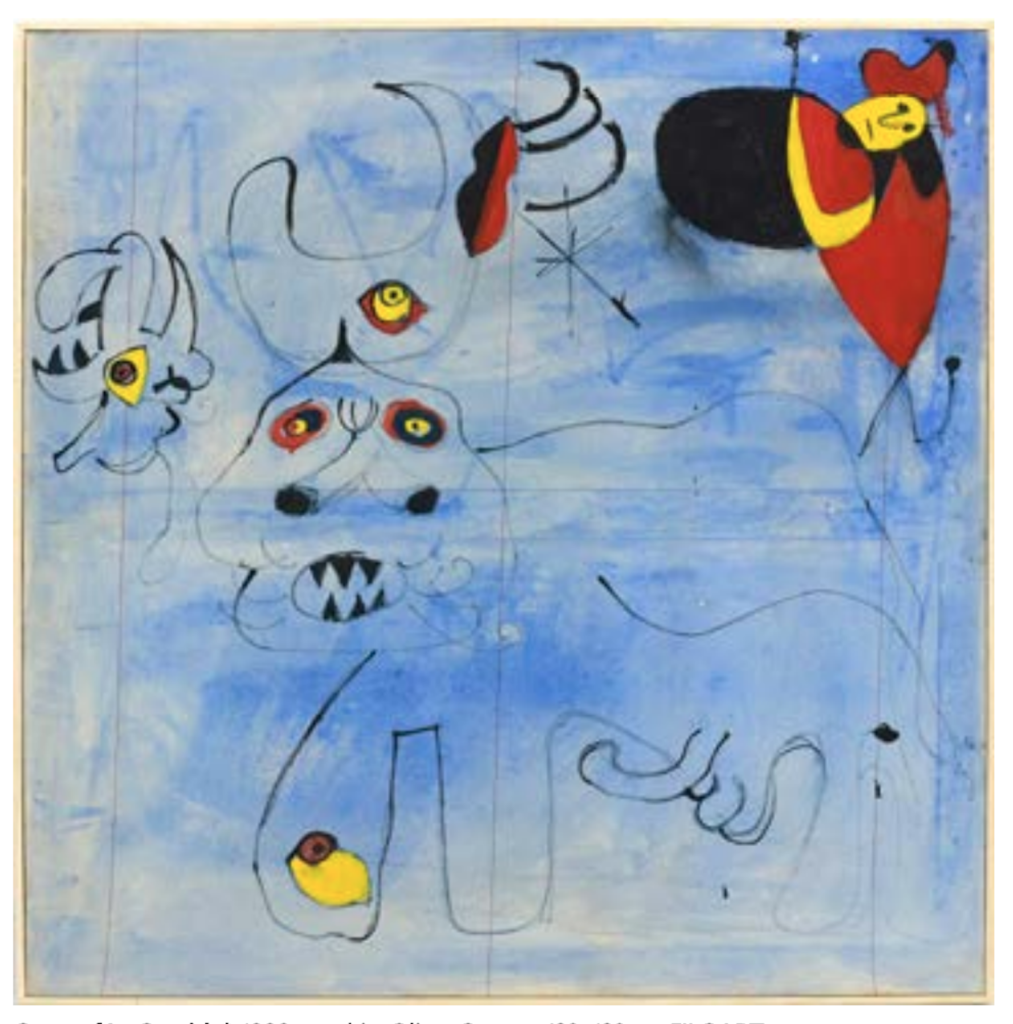
Copy of La Corrida, 1986, Oil on Canvas 120cm X 120 cm, FILOART
During the history of art there have been many examples where a bull was used as a motif in drawings and paintings. From the drawings in the cave of Altamira, the artwork of Ancient Greece, Rome, the Renaissance and then later in the works of artists like Goya, Picasso, Miro or Lichtenstein, to the present – bulls were often used as motifs, in one form or another.. The case of “Copy of La Corrida” is little bit different.. The group FILOART simply took one artwork depicting a bull, by the painter Juan Miro, and used the entire work for their motif. Does that mean that this work was simply re-painted/copied? The question here is: what is the difference between drawing (copying) a bull and drawing (copying) a painting depicting a bull? “Copy of La Corrida” is made in “The Age of Mechanical Reproduction”**, when the technical possibilities for reproduction were (and still are) huge. Even if this work is a “copy”, it was not made mechanically but by hand, it was painted on a canvas. What kind of work is this, if its title has the word “copy” in it (“Copy of La Corrida”)? If this work is titled as a copy, does that mean that this work is a copy? Yes and no. But maybe that’s not the main question, maybe this is just a small hint about the complexity of this work. This work is almost identical to the original. If we know the original well (“La Corrida”) then we know that, this work (“Copy of La Corrida”) does not pretend to be indistinguishable from the original work. While the work of Miro is in the form of a rectangle (114×145 cm), the work of FILOART is in the form of a square (120 x120cm).*** This means that this work changed the form of the original, forcing a rectangle into a square. Even if this work is a “copy”, in one way or another, nevertheless it includes both the original and the copy. This means that this work cannot be only a “copy”, but the copy and the original at the same time. It seems that this work is a kind of tautology and a paradox in one. Is this work trying to explain something to us, or “only” opens a new field of questions, or are there answers hiding inside the questions? What is an original work? What is the meaning of a copy? From which moment we can call one work a copy and the other an original? What kind of value has a copy compared to the original? Is the copy, another/different, original or something more?
Let’s break it down: If we paint a realistic work, then this work could be called a realistic work. If we paint a copy of a realistic work, then this work could be called a realistic copy of the realistic work. If we paint an abstract work, then this work could be called an abstract work. But what happens if we copy an abstract work? Is it a realistic or an abstract work or something else? We cannot call this work a realistic work because this work shows an abstract image. Nor can we say that this work is an abstract work because it is painted realistically. This shows us that this work is more than what we can see in this painting. Also, this work shows that the copy is comprised of more than the original work. When we observe this work, what are we looking at? Are we looking at the “La Corrida” or why, how, in what form this work was made, or both? The answer is none of them! From the text above we can come to the conclusion that this work does not thematize at all what, but how, we observe!1
______________________________
*This work was shown at the presentation: “This is not an Exhibition but the Opposite of it!!!!” At the same presentation the work “Copy of the detail from the Cave of Altamira” was shown.
**”The Work of Art in the Age of Mechanical Reproduction” (Das Kunstwerk im Zeitalter seiner technischen Reproduzierbarkeit) by Walter Benjamin, 1935.
*** Several works in the presentation: “This is not an Exhibition but the Opposite of it!!!!” which inter alia, deals with the history of art, have noticeably identical measures and the same form (square).